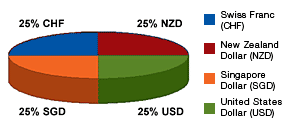
The Stable Currency Index currently comprises equal-value portions of four currencies:
- the Swiss franc
- the Singapore dollar
- the New Zealand dollar
- the U.S. dollar
How do we choose the SCI's component currencies?
Each currency is the most attractive one within its global financial quadrant from the standpoint of political and fiscal stability. The four quadrants are Europe-Africa, Asia, Oceania and the Americas. To arrive at the safest and most stable currency in each of those quadrants, EWI analyzes each issuing country based on:
- The liquidity of its banking system
- Its national savings rate
- Its central bank's integrity and transparency
- The history of its legal system
- The extent of its political neutrality
- The degree to which it is isolated geographically
- Its prospects for inflation
- Geographical detachment from the other selections
Why is it important to include four currencies?



